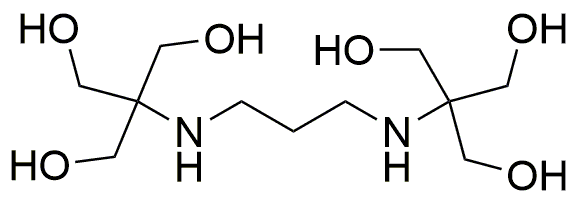1,3-Bis(tris(hydroxymethyl)methylamino)propane is widely utilized in research focused on:
- Biotechnology: This compound serves as a buffering agent in biological systems, helping to maintain pH stability in cell cultures and enzyme reactions, which is crucial for accurate experimental results.
- Pharmaceutical Development: It is used in drug formulation to enhance the solubility and stability of active pharmaceutical ingredients, making it easier to develop effective medications.
- Analytical Chemistry: The compound acts as a stabilizing agent in various analytical techniques, improving the reliability of results in methods such as chromatography and spectrometry.
- Cosmetic Industry: Its properties make it an excellent ingredient in skincare formulations, providing hydration and stability to products, which enhances their performance and shelf life.
- Environmental Science: It is applied in the treatment of wastewater, where it helps in the removal of heavy metals and other contaminants, contributing to cleaner water systems.
General Information
Properties
Safety and Regulations
Applications
1,3-Bis(tris(hydroxymethyl)methylamino)propane is widely utilized in research focused on:
- Biotechnology: This compound serves as a buffering agent in biological systems, helping to maintain pH stability in cell cultures and enzyme reactions, which is crucial for accurate experimental results.
- Pharmaceutical Development: It is used in drug formulation to enhance the solubility and stability of active pharmaceutical ingredients, making it easier to develop effective medications.
- Analytical Chemistry: The compound acts as a stabilizing agent in various analytical techniques, improving the reliability of results in methods such as chromatography and spectrometry.
- Cosmetic Industry: Its properties make it an excellent ingredient in skincare formulations, providing hydration and stability to products, which enhances their performance and shelf life.
- Environmental Science: It is applied in the treatment of wastewater, where it helps in the removal of heavy metals and other contaminants, contributing to cleaner water systems.
Documents
Safety Data Sheets (SDS)
The SDS provides comprehensive safety information on handling, storage, and disposal of the product.
Product Specification (PS)
The PS provides a comprehensive breakdown of the product’s properties, including chemical composition, physical state, purity, and storage requirements. It also details acceptable quality ranges and the product's intended applications.
Certificates of Analysis (COA)
Search for Certificates of Analysis (COA) by entering the products Lot Number. Lot and Batch Numbers can be found on a product’s label following the words ‘Lot’ or ‘Batch’.
*Catalog Number
*Lot Number
Certificates Of Origin (COO)
This COO confirms the country where the product was manufactured, and also details the materials and components used in it and whether it is derived from natural, synthetic, or other specific sources. This certificate may be required for customs, trade, and regulatory compliance.
*Catalog Number
*Lot Number
Safety Data Sheets (SDS)
The SDS provides comprehensive safety information on handling, storage, and disposal of the product.
DownloadProduct Specification (PS)
The PS provides a comprehensive breakdown of the product’s properties, including chemical composition, physical state, purity, and storage requirements. It also details acceptable quality ranges and the product's intended applications.
DownloadCertificates of Analysis (COA)
Search for Certificates of Analysis (COA) by entering the products Lot Number. Lot and Batch Numbers can be found on a product’s label following the words ‘Lot’ or ‘Batch’.
*Catalog Number
*Lot Number
Certificates Of Origin (COO)
This COO confirms the country where the product was manufactured, and also details the materials and components used in it and whether it is derived from natural, synthetic, or other specific sources. This certificate may be required for customs, trade, and regulatory compliance.

